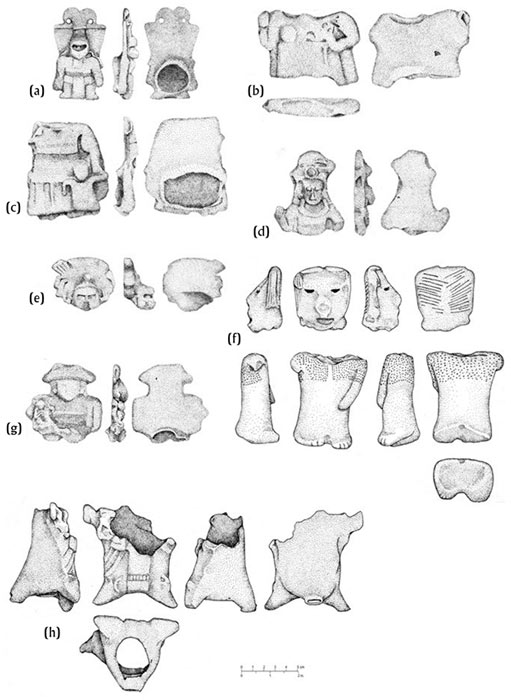A fresh analysis of artifacts collected from a salt-making facility submerged beneath a lagoon in Belize has revealed enlightening details about the organization and functioning of the Maya salt production industry during the Maya Empire’s Classical Period (250 to 900 AD). In a new article in the journal Ancient Mesoamerica , archaeologists Heather McKillop and E. Cory Sills introduced the results of their study, which highlights the skills of the Maya salt makers, who apparently operated right out of their own homes.

Map of the Maya salt making sites just north of Punta Gorda, Belize, where the recent study was carried out. ( Mary Lee Eggart / Ancient Mesoamerica journal )
The Amazing Maya Salt Works of Belize
The Maya civilization of Central America reached an astonishing level of sophistication during its Classical Period. The robust Maya economy produced vital goods in mass quantities, which was necessary to meet the needs of a population that numbered in the millions.
The accomplishments of the legendary Maya civilization were many. Among their most notable achievements was the creation of a large-scale salt industry , which was commercial in its orientation and capable of meeting the needs of Maya consumers living throughout the empire.
The Maya used salt primarily as a meat preservative ( refrigeration in the first millennium AD was not an option). And they used tons of salt, all of which needed to be produced and shipped inland to the far reaches of the empire from salt flats found exclusively along the Yucatán coast of Central America.
Louisiana State University archaeologist Heather McKillop is the world’s foremost expert on the salt production capacities of the legendary Maya civilization. She has been studying this subject for nearly 20 years and has learned many important and details about how the Maya people mass-produced this essential product.
McKillop has explored the ruins of many salt-producing facilities on ancient Maya territory, which spanned from southern Mexico through modern-day Guatemala, Honduras, Belize, El Salvador, and Nicaragua. Much of her attention, however, has been focused on the ancient Paynes Creek Salt Works of Belize, which were flooded by rising sea levels centuries ago.
McKillop and her associates have been exploring the ruins at the Paynes Creek Salt Works since 2004. They’ve collected truckloads of artifacts from their underwater excavations, including many types of tools and fragments of ceramic jars used for brine-boiling (salt extraction) and other kitchen operations. They’ve also found the remains of wooden poles and thatched roofs that were used to build the salt-producing structures.
The seawater of mangrove lagoons has strong preservative qualities, which has protected the Maya salt works ruins and artifacts from experiencing normal levels of decay. Slowly but surely, McKillop and her team members have been putting together the pieces of the Maya salt-making puzzle , thanks in large part to their discoveries at this unique and historically significant site.
Unfortunately, pandemic-related restrictions forced them to halt all fieldwork in Belize in 2020. Not wanting to stop her studies altogether, McKillop recruited one of her former students, E. Cory Sills, who is currently an associate professor of archaeology at the University of Texas-Tyler, to help her complete a new analysis of the artifacts that had been collected from the lagoon in the past.

Wooden post 305 from the Ek Way Nal Maya salt making site. ( Heather McKillop / Ancient Mesoamerica Journal )
Developing an Industry from ‘Surplus Household Production’
For the purposes of this study, the archaeologists focused exclusively on a complex within the larger works known as Ek Way Nal site. McKillop thought artifacts from this particular 10-structure facility were ideal for her research project, which was designed to uncover more information about how Maya salt-makers organized their activities. McKillop was also interested in learning more about the timeline of construction at the site.
“I decided to submit a wood post sample for radiocarbon dating from each building at Ek Way Nal to see if they all dated to the same time, which was suggested by the visibility of artifacts and buildings on the sea floor,” she explained in a Louisiana State University press release .
When the results of these tests came in, McKillop was able to reconstruct a pattern of building that began in the Late Classic Period (600 to 800 AD) and continued into the Terminal Classic Period (800 to 900 AD), when the Maya Empire was in irreversible decline. The site experienced four successive building phases, with construction likely expanding as the empire’s population expanded.
More than anything, McKillop wanted to learn more about the lives and lifestyles of the workers at the salt-making complex. Did they come to work each morning and return to their homes each afternoon like modern factory workers? Or did they live onsite, integrating their home lives with their working lives?
Going in, McKillop was leaning toward the latter explanation. She believed that some of the structures at Ek Way Nal had been used for other activities besides salt-making, based on the distribution of tools and pottery and differences in the alignments of the preserved wooden poles and thatched roofs.
To prove her thesis, she planned to compare the characteristics of the tools and pottery pieces found at Ek Way Nal, plus the alignment of the wooden posts and thatch roofs of the Ek Way Nal structures, to similar finds at another salt-making site where people lived and worked on diverse tasks.
“Using the well-studied site, Sacapulas, Guatemala, as a model, worked well to develop archaeological expectations for different activities for brine boiling in a salt kitchen, a residence and other activities, including salting fish,” she said.
What McKillop and Sills’ study showed is that salt-making at Ek Way Nal was a type of “surplus household production,” meaning the salt-makers literally performed their work in their own backyards like a cottage industry.
“There were likely separate residences and salt kitchens,” McKillop and Sills wrote in their Ancient Mesoamerica journal study. “Other related activities, including salting fish, wood working, grinding corn, and rituals pertaining to the needs of householders and salt kitchen workers, occurred both indoors and outdoors. Some activities, notably salt-drying fish, were part of the surplus salt production and can be described as contingent multi-crafting. Other activities, such as rituals, eating, or wood working, were carried out in households as part of everyday life.”

Maya ocarinas found at the Maya salt making sites of Belize. (a) a boxer; (b) woman with child; (c) woman with child #2; (d) a woman; (e) boxer’s head; (f) Punta Ycacos unslipped figurine; (g) woman holding infant; (h) a vessel. (Mary Lee Eggart / Ancient Mesoamerica journal )
The Ek Way Nal Maya Salt Makers and Maya Trade Networks
The salt producers at Ek Way Nal were partially self-sufficient, using some of the salt they made for their own needs. But they were also full participants in the Maya trade networks, producing valuable goods that would have been easy to exchange.
McKillop and Sills noted that Ek Way Nal was “a community well-integrated into waterborne transport and trade along rivers and the coast. Nonlocal goods and resources were evenly distributed among households, as is expected for participation in a marketplace economy.”
Over time, the various families who participated in this salt-making economy in the Paynes Creek Salt Works region may have coordinated their efforts to increase efficiency. As population in the Maya Empire increased the profitability of the ever-growing salt producing industry would have risen substantially over time, creating something that may have resembled a large and relatively prosperous worker’s cooperative.
Top image: Flotation survey at the Ek Way Nal Maya salt making site in Belize, with flags marking the locations of wooden posts below the sea surface. Source: Heather McKillop / Ancient Mesoamerica journal
By Nathan Falde
Related posts:
Views: 0
 RSS Feed
RSS Feed

















 November 20th, 2021
November 20th, 2021  Awake Goy
Awake Goy  Posted in
Posted in  Tags:
Tags: 
















